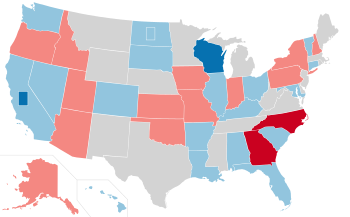| ← 1990 1991 1992 1993 1994 → Presidential election year | |
| Election day | November 3 |
|---|---|
| Incumbent president | George H. W. Bush (Republican) |
| Next Congress | 103rd |
| Presidential election | |
| Partisan control | Democratic gain |
| Popular vote margin | Democratic +5.6% |
| Electoral vote | |
| Bill Clinton (D) | 370 |
| George H. W. Bush (R) | 168 |
 | |
| 1992 presidential election results. Red denotes states won by Bush, blue denotes states won by Clinton. Numbers indicate the electoral votes won by each candidate. | |
| Senate elections | |
| Overall control | Democratic hold |
| Seats contested | 36 of 100 seats (34 Class 3 seats + 2 special elections) |
| Net seat change | None[1] |
 | |
| 1992 Senate results
Democratic gain Democratic hold | |
| House elections | |
| Overall control | Democratic hold |
| Seats contested | All 435 voting members |
| Popular vote margin | Democratic +5% |
| Net seat change | Republican +9 |
 | |
| 1992 House of Representatives results
Democratic gain Democratic hold | |
| Gubernatorial elections | |
| Seats contested | 14 (12 states, 2 territories) |
| Net seat change | Democratic +2 |
 | |
| 1992 gubernatorial election results
Democratic gain Democratic hold Republican gain Republican hold New Progressive gain Nonpartisan | |
The 1992 United States elections elected state governors, the president of the United States, and members of the 103rd United States Congress. The election took place after the Soviet Union crumbled and the Cold War ended, as well as the redistricting that resulted from the 1990 census. Often considered "The Year Of The Woman," these elections brought an increased number of female politicians to Washington such as Dianne Feinstein (D-CA) and Carol Moseley Braun (D-IL). Governor Bill Clinton of Arkansas defeated incumbent president George H. W. Bush and businessman Ross Perot in the presidential election. The Democratic Party maintained their control of both chambers of Congress. This is the first Democratic trifecta since the Republican victory in the 1980 elections and the last one during the 20th century and the last one overall until 2008.
In the presidential election, Democratic governor Bill Clinton of Arkansas defeated Republican incumbent president George H. W. Bush and Texas businessman Ross Perot. Clinton easily won the electoral college with 370 electoral votes, but took just 43 percent of the popular vote, the fourth-lowest share of any victorious presidential candidate. Perot's independent candidacy won the largest share of the popular vote of any third party or independent candidate since Theodore Roosevelt's 1912 candidacy. Clinton defeated former California governor Jerry Brown and former Massachusetts senator Paul Tsongas to take the Democratic nomination. Bush defeated a primary challenge from commentator, and former Reagan White House Director of Communications Pat Buchanan to earn re-nomination as the Republican candidate.[2]
A small number of seats changed hands in the Senate, but Democrats retained a comfortable majority.[3] Democrats won the national popular vote for the House of Representatives by a margin of five percentage points, but Republicans won a net gain of nine seats. In the gubernatorial elections, the Democratic Party won a net gain of two states.
- ^ Republicans picked up one seat in the regularly-scheduled elections, while Democrats picked up one seat in a special election.
- ^ "1992 Presidential Election". The American Presidency Project. Retrieved 13 August 2011.
- ^ "Party Division in the Senate, 1789-Present". United States Senate. Retrieved 25 June 2014.